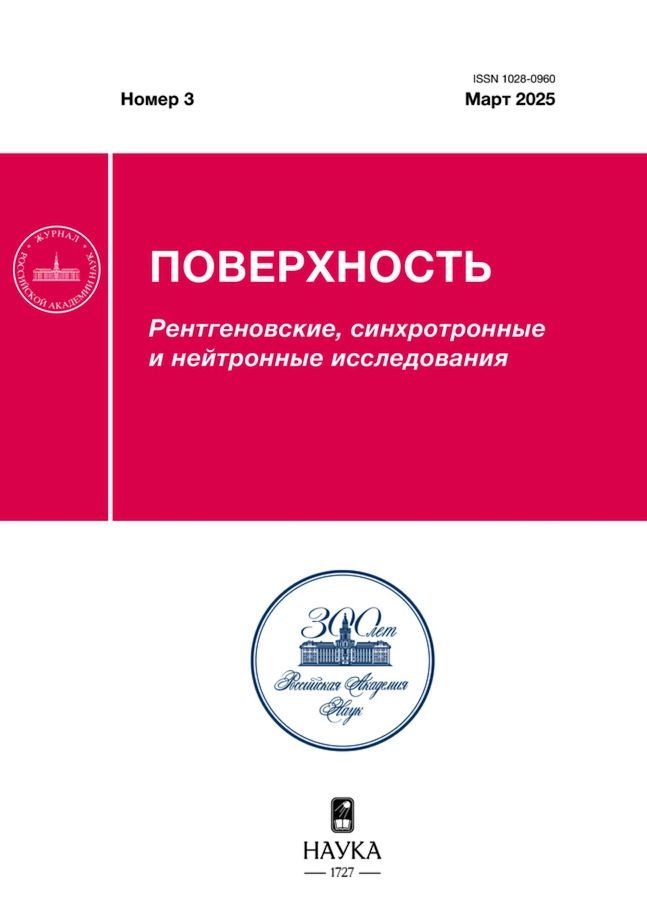On the features of the formation of polar distribution of sputtered atoms in the md model of the (001) Ni face sputtering
- 作者: Musin A.I.1,2, Samoilov V.N.3
-
隶属关系:
- Moscow State University of Technology “STANKIN”, Institute of Digital Intelligent Systems
- Vyatka State University, Institute of Mathematics and Information Systems
- Lomonosov Moscow State University, Faculty of Physics
- 期: 编号 3 (2025)
- 页面: 17-22
- 栏目: Articles
- URL: https://j-morphology.com/1028-0960/article/view/687521
- DOI: https://doi.org/10.31857/S1028096025030039
- EDN: https://elibrary.ru/EKSWMQ
- ID: 687521
如何引用文章
详细
Using a modern complete molecular dynamics model of single crystal sputtering taking into account ion incidence on the surface, the mechanisms of formation of the polar and azimuthal angle distribution of atoms sputtered from the surface of the (001) Ni face by Ar ions with an energy of 200 eV are studied. It is shown that the sputtered atoms, over focused by the azimuthal angle, eject only near the directions corresponding to the directions to the centers of lenses of two atoms in the surface plane neighboring to the ejecting atom. It is found that in the polar angular distribution of sputtered atoms with an energy of 2.5 ± 0.1 eV in the range of the azimuthal angle of 87° ± 1.5°, close to the center of the lens, three maxima formed by atoms with significantly different mechanisms of emission are observed. It is concluded that the formation of these maxima occurs only due to the surface mechanism of single crystal sputtering.
全文:
作者简介
A. Musin
Moscow State University of Technology “STANKIN”, Institute of Digital Intelligent Systems; Vyatka State University, Institute of Mathematics and Information Systems
编辑信件的主要联系方式.
Email: samoilov@polly.phys.msu.ru
俄罗斯联邦, Moscow; Kirov
V. Samoilov
Lomonosov Moscow State University, Faculty of Physics
Email: samoilov@polly.phys.msu.ru
俄罗斯联邦, Moscow
参考
- Михайленко М.С., Пестов А.Е., Зорина М.В., Чернышев А.К., Чхало Н.И., Шевчук И.Э. // Поверхность. Рентген., синхротр. и нейтрон. исслед. 2023. № 12. С. 25. https://doi.org/10.31857/S1028096023120154
- Андрианова Н.Н., Борисов А.М., Машкова Е.С., Овчинников М.А., Суминов И.В. // Поверхность. Рентген., синхротр. и нейтрон. исслед. 2023. № 4. С. 10. https://doi.org/10.31857/S1028096023040027
- Лядов Н.М., Базаров В.В., Вахитов И.Р., Гумаров А.И., Ибрагимов Ш.З., Кузина Д.М., Файзрахманов И.А., Хайбуллин Р.И., Шустов В.А. // Физика твердого тела. 2021. Т. 63. № 10. С. 1687. https://doi.org/10.21883/FTT.2021.10.51424.117
- Хисамов Р.Х., Тимиряев Р.Р., Сафаров И.М., Мулюков Р.Р. // Письма о материалах. 2020. Т. 10. № 2. С. 223. https://doi.org/10.22226/2410-3535-2020-2-223-226
- Борисов А.М., Машкова Е.С., Овчинников М.А., Хисамов Р.Х., Мулюков Р.Р. // Поверхность. Рентген., синхротр. и нейтрон. исслед. 2022. № 3. С. 71. https://doi.org/10.31857/S1028096022030062
- Sigmund P. // Phys. Rev. 1969. V. 184. № 2. P. 383. https://doi.org/10.1103/PhysRev.184.383
- Самойлов В.Н. // Изв. АН СССР. Сер. физ. 1990. Т. 54. № 7. С. 1283.
- Мусин А.И., Самойлов В.Н. // Поверхность. Рентген., синхротр. и нейтрон. исслед. 2024. № 6. С. 20.
- Kornich G.V., Betz G. // Nucl. Instrum. Methods Phys. Res. B. 1998. V. 143. № 4. P. 455. https://doi.org/10.1016/S0168-583X(98)00410-8
- Kornich G.V., Betz G., Bazhin A.I. // Nucl. Instrum. Methods Phys. Res. B. 1999. V. 153. № 1–4. P. 383. https://doi.org/10.1016/S0168-583X(99)00218-9
- Ackland G.J., Tichy G., Vitek V., Finnis M.W. // Phil. Mag. A. 1987. V. 56. № 6. P. 735. https://doi.org/10.1080/01418618708204485
- Ziegler J.F., Biersack J.P., Littmark U. // Charge States and Dynamic Screening of Swift Ions in Solids. Proc. of the U.S.-Japan Seminar on Charged-Particle Penetration Phenomena, 25–29 January 1982, Honolulu, Hawaii, the U.S.A. The Oak Ridge National Laboratory Publ., Oak Ridge, Tennessee, U.S.A, 1983. P. 88.
- Gao F., Bacon D.J., Ackland G.J. // Phil. Mag. A. 1993. V. 67. № 2. P. 275. https://doi.org/10.1080/01418619308207158
- Самойлов В.Н., Мусин А.И. // Изв. РАН. Сер. физ. 2018. Т. 82. № 2. С. 171. https://doi.org/10.7868/S0367676518020084
- Самойлов В.Н., Мусин А.И., Ананьева Н.Г. // Изв. РАН. Сер. физ. 2016. Т. 80. № 2. С. 122. https://doi.org/10.7868/S0367676516020289
- Eltekov V.A., Samoylov V.N., Yurasova V.E., Motaweh H.A. // Nucl. Instrum. Methods Phys. Res. B. 1986. V. 13. № 1–3. P. 443. https://doi.org/10.1016/0168-583X(86)90544-6
- Wehner G.K. // J. Appl. Phys. 1955. V. 26. № 8. P. 1056. https://doi.org/10.1063/1.1722136
- Юрасова В.Е., Плешивцев Н.В., Орфанов И.В. // ЖЭТФ. 1959. Т. 37. Вып. 4. С. 966.
- Rübesame D., Niedrig H. // Radiat. Eff. Def. Solids. 1996. V. 138. № 1–2. P. 49. https://doi.org/10.1080/10420159608211508
- Samoilov V.N., Tatur A.E., Kovaleva N.A., Kozhanov A.E. // Nucl. Instrum. Methods Phys. Res. B. 1999. V. 153. № 1–4. P. 319. https://doi.org/10.1016/S0168-583X(99)00216-5
- Шпиньков В.И., Самойлов В.Н. // Поверхность. Рентген., синхротр. и нейтрон. исслед. 2009. № 3. С. 73.
- Voevodin Vl.V., Antonov A.S., Nikitenko D.A., Shvets P.A., Sobolev S.I., Sidorov I.Yu., Stefanov K.S., Voevodin Vad.V., Zhumatiy S.A. // Supercomputing Frontiers and Innovations. 2019. V. 6. № 2. P. 4. https://doi.org/10.14529/jsfi190201
补充文件













